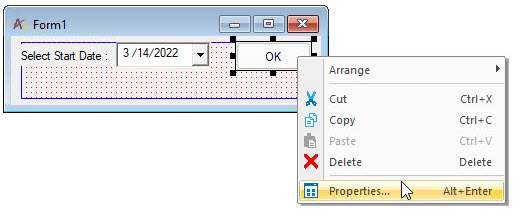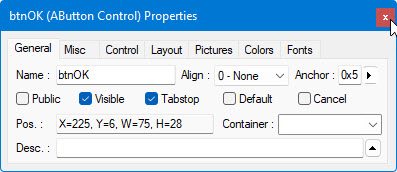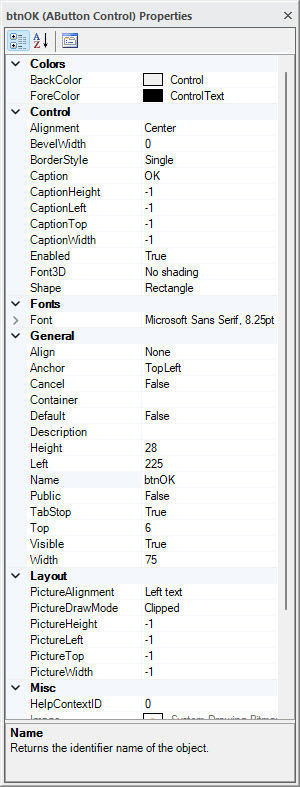Setting Form Control Properties
Each of the ATEasy
controls has distinct
properties which can be set at design time. The way in which you can set
these properties is through the various tabs of the Properties window.
There are three ways of viewing the Properties window for a control.
Double-click on the
control in the forms you are editing or right click on the control,
and then click on the Properties command  .
.
3. Right-click on the control, and then select the Properties option
from the pop-up menu.

The Properties dialogs
for the different controls have varying numbers of tabs, depending
on the numbers of screens of parameters that can be set. There are
several tabs which are common to most of the controls: General, Misc,
Control, Colors, and Fonts. The example below is for a AButton control
named btnOK:

The General tab has the Name of the control, as well as
its position and description. The Misc.
tab has fields for information used in integrating the control with online
Help. The Control tab has the
Caption of the control, along
with its Appearance, Alignment, and default value. The Colors
tab allows you to set the colors for certain properties of the control.
Finally, the Fonts tab permits
you to set the font, style, and size for any text displayed as part of
the control.
Properties Grid Window (v10)
In addition to Properties Window, you can set the control properties
using the Properties Grid Window. This window displays the properties
in a grid. This window is especially useful when setting .Net Control
properties since these controls do not have properties pages as ActiveX
controls.

Name versus Caption
It's necessary to make the distinction between the Name
property and the Caption property, as they are often confused.
The Name property is the identification
used in the programming code. It is often a sort of description of the
use of the control, for example, btnOK or btnSwitchMainPower1. This property
should not contain any embedded spaces.
The Caption property is the
text description of the control. It is often displayed on the control
to show the user what that control does, for example, "OK".
This property can contain spaces.
For More Information
For more information on the properties of
a given control, consult the appropriate chapter in the Programming
Reference.
![]() .
.

